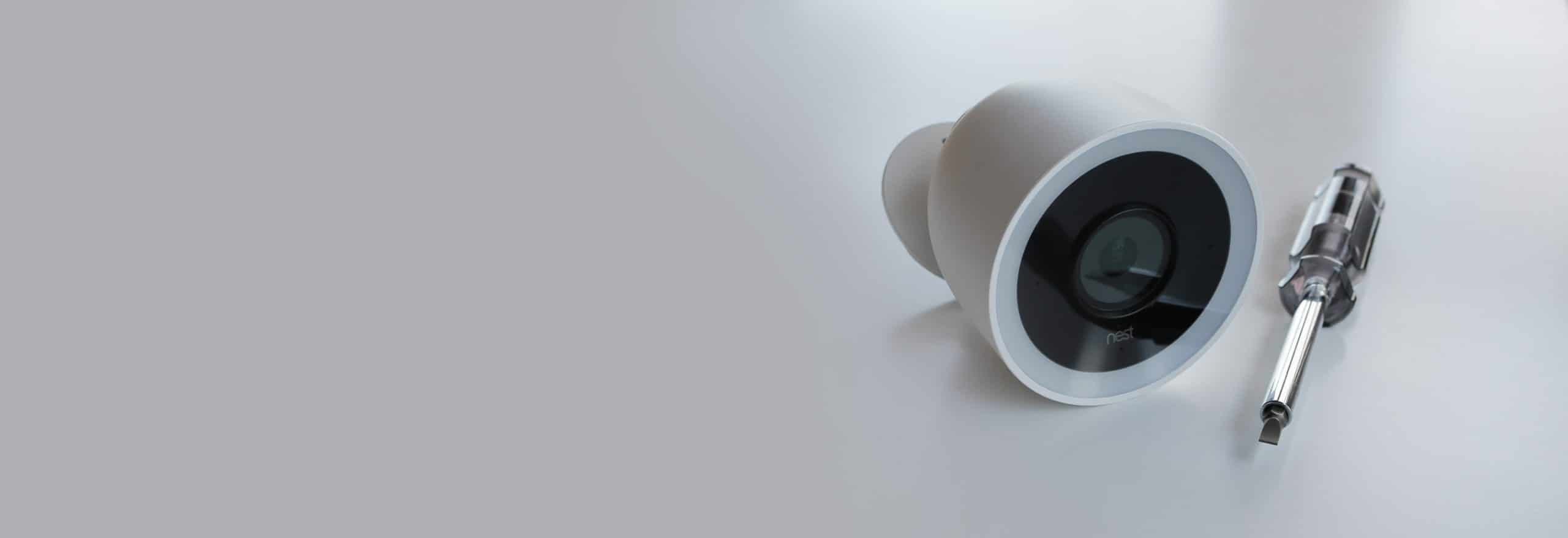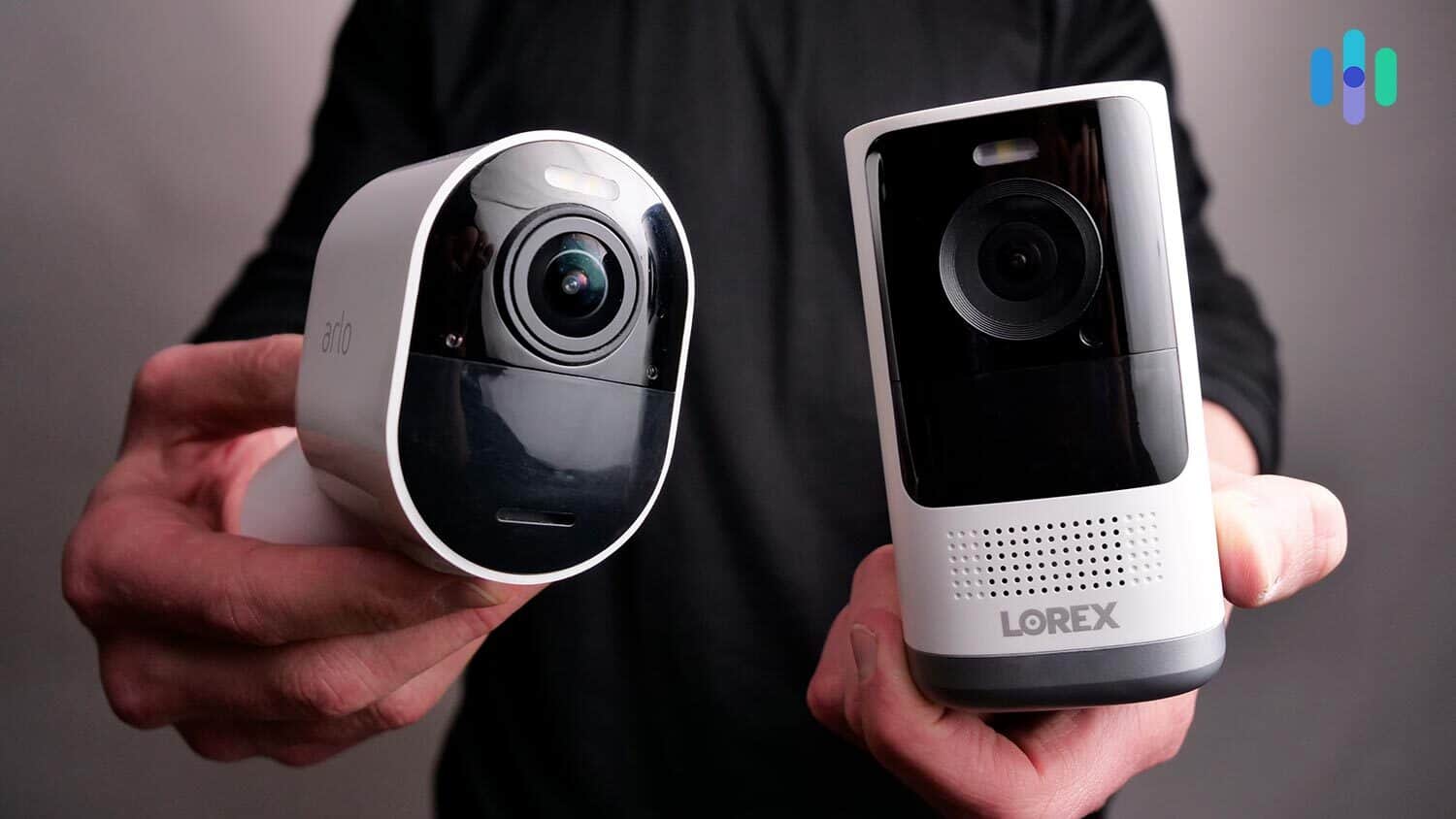Editor’s Note: Not all security systems need Wi-Fi. If you’ve got an unreliable network, we recommend getting a wired security system that comes with all the essentials to keep your home safe.
- Wi-Fi plays a big role in video monitoring, but there are security cameras that don’t need Wi-Fi.
- Local storage is the key; store videos into a microSD card or local recorder and play them back on your computer.
- Want live video streaming without Wi-Fi? Arlo Go is the solution. Read our Arlo review for more.
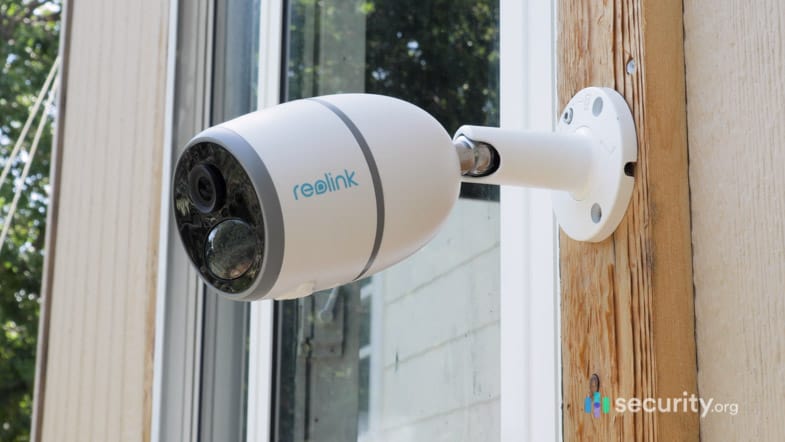
Some of the best security cameras use Wi-Fi to stream or record video, but not all of them rely on a steady internet connection to keep your property safe. We’ve tested several cellular-enabled options that, in some cases, are even more dependable than their Wi-Fi counterparts. Plus, modern security cameras that record locally have gotten smarter with many offering hybrid features that give you the best of both worlds.
That answers the question of whether there are security cameras that work without Wi-Fi, but how do you know which one to choose? Our team spent hundreds of hours testing cameras specifically for folks without reliable internet connections. We’ll show you exactly what works, what doesn’t, and how to pick the right solution for your specific situation. Let’s dive in.
Pro Tip: No Wi-Fi? No problem. Lorex security cameras can record every second of every day, online and offline. Read our Lorex review to see how you can turn your Wi-Fi-free space into a secure fortress.
Can Security Cameras Function Normally Without Wi-Fi?
Here's the bottom line: security cameras can work without Wi-Fi, but you'll need to adjust your expectations. No-Wi-Fi cameras that provide live surveillance and real-time alerts require cellular connectivity, which is an extra ongoing cost. If you want to avoid that cost, you’d have to use cameras with local storage. They can record video, but they can’t stream live video and provide alerts. Here are some options to look into:
Cellular Signal-Ready Security Cameras
Think of cellular cameras like giving your security system its own data plan. In our testing, we found they deliver virtually identical functionality to Wi-Fi cameras—live streaming, instant push notifications, and cloud storage—just over a different network.
Just like your phone bill, you’ll need to budget for monthly cellular service. Plans typically range from $10 to $40 per camera, depending on your data needs and carrier. You’ll also pay a premium for cellular-capable cameras. When we tested the latest Arlo Go 2 and Reolink Go Plus, both cost us around $250. That’s on the high end of security camera prices. Needless to say, these devices are far from the best affordable cameras.
Still, let’s take a closer look at Arlo Go and Reolink Go.
- Arlo Go 2: Most of the Arlo home security cameras we test connect to Wi-Fi, but the Arlo Go lineup is fully cellular. This camera offers carrier flexibility, supporting Verizon, AT&T, T-Mobile, US Cellular, and Arlo Mobile’s 4G LTE network. They can also record to the cloud, send notifications, livestream videos, and connect to the Arlo app for monitoring.
- Reolink Go: We’ve reviewed several Wi-Fi cameras from Reolink, but we wanted to try one of the newer versions of the Reolink Go, which uses a 4G LTE connection. However, it does need a Nano SIM card and cellular data plan to get it working. While that adds costs, the Reolink Go has a few budget-friendly features like a solar panel accessory for non-stop power supply and a microSD card slot so you don’t need to pay a monthly subscription for cloud storage.
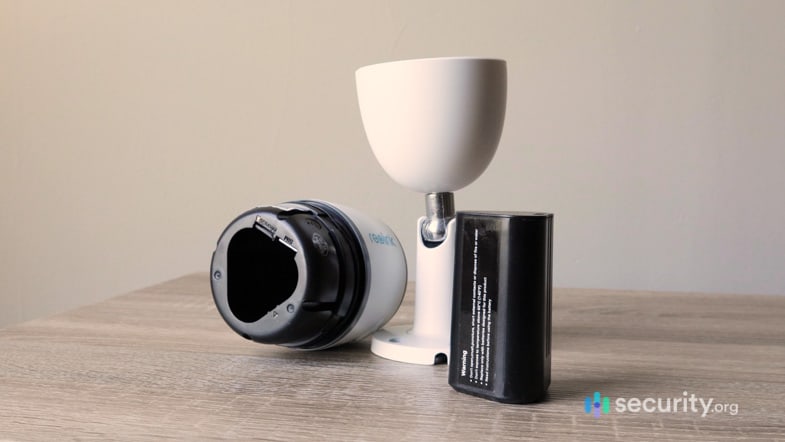
As we touched on earlier, there are ongoing usage costs to contend with. For our Arlo Go 2, we pay around $10 to $15 per month for a 30GB data plan. We also had the option to pay for cloud storage, but we chose to use microSD for storage, which we bought off Amazon. It saved us about $96 annually compared to a cloud storage plan.
Expert Tip: Arlo also offers an unlimited camera cloud plan for $24.99 per month. It provides 60 days of video history, advanced AI detection for people, packages, vehicles, and animals, and theft replacement. You’ll still have to pay for the data plan for each camera.
Speaking of data plans, we don’t recommend streaming for long periods over a cellular network. During our testing, we burned through 1GB of data for every two hours of continuous HD streaming. We also recommend tweaking your motion detection zones and sensitivity settings because cloud recording also uses data. The adjustments we made cut false alarms by up to 70 percent. We also scheduled our cameras to record only during specific hours when we’re typically away, further stretching our data allowance.
Security Cameras With Local Video Storage
If monthly data fees make you cringe, cameras with local storage offer a compelling alternative. We’ve found this approach particularly effective for businesses needing round-the-clock surveillance. It gives you continuous recording without impacting your network bandwidth or racking up data charges. It’s not a perfect solution, though.
The only issue we have with these cameras is they operate on a closed network. So, while you’re out gallivanting with friends and family, you can’t receive push notifications or stream live footage like you can with a cellular security system. That said, the latest models from brands like Lorex and Swann now offer hybrid functionality. They record locally 24/7 but can still connect to your network when available to send smart alerts and enable remote viewing.
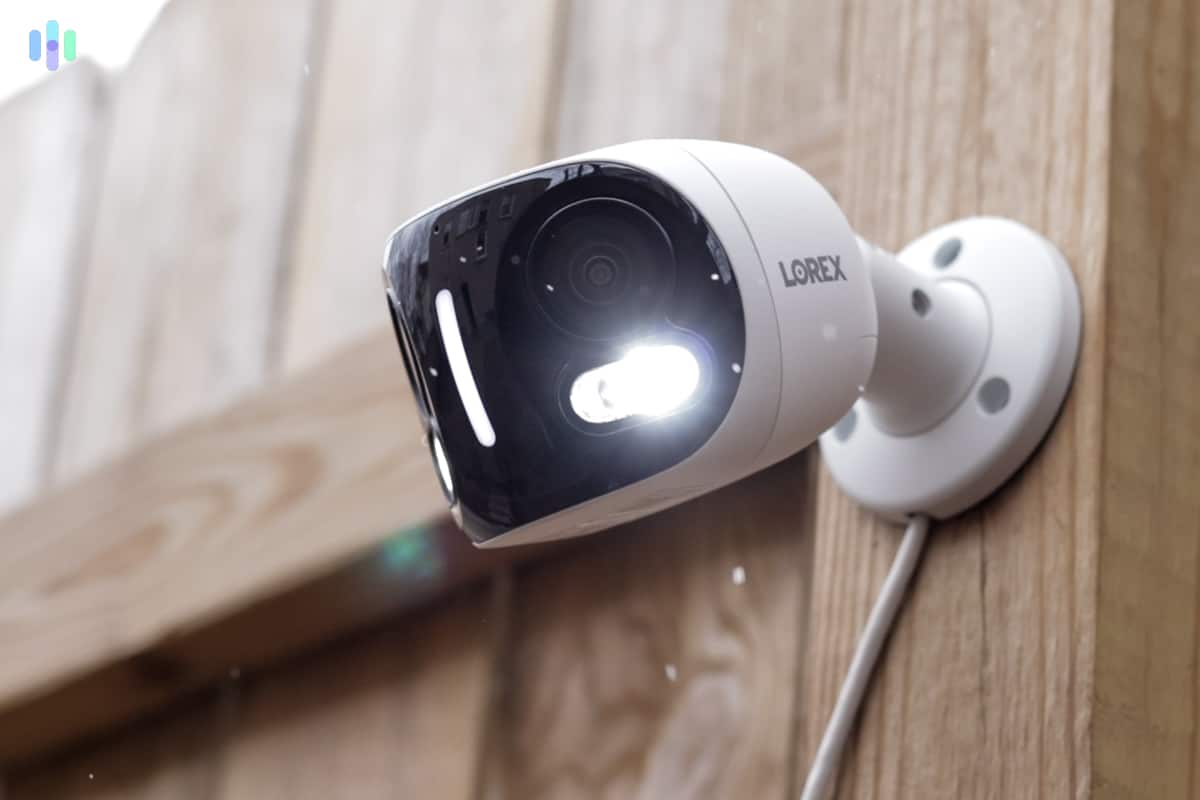
Unlike cloud storage, you can’t access the videos from anywhere. You also run the risk of corrupted files or someone stealing the camera or DVR. We’ve learned to mitigate these risks by keeping our DVR in a locked, ventilated cabinet. We also back up critical footage to an external drive weekly.
If you can live with those drawbacks, these are the different types of cameras with local video storage.
- CCTV: CCTV cameras, or closed-circuit television cameras, are used by businesses and police for surveillance; they’re not usually used for home security purposes. Instead of watching the footage on an app, security personnel watch CCTV footage on monitors, and storage is on either a DVR or an NVR. CCTV cameras include analog and IP cameras.
- Analog: Analog cameras transmit video from the camera to a DVR, often via coaxial cable. While it’s older technology, analog systems remain popular for their reliability and lower cost. Basic four-camera analog systems with 1080p resolution start at around $500.
- HD-over-coax: In HD-over-coax cameras, uncompressed video travels from cameras to recorders via coaxial cable. These systems support up to 4K resolution while using existing coaxial wiring, making them good for upgrading older analog systems.
- IP: An IP camera is usually synonymous with a surveillance camera, as it’s a lot more expensive than regular home security cameras. However, some IP cameras offer more advanced features like facial recognition and license plate reading.
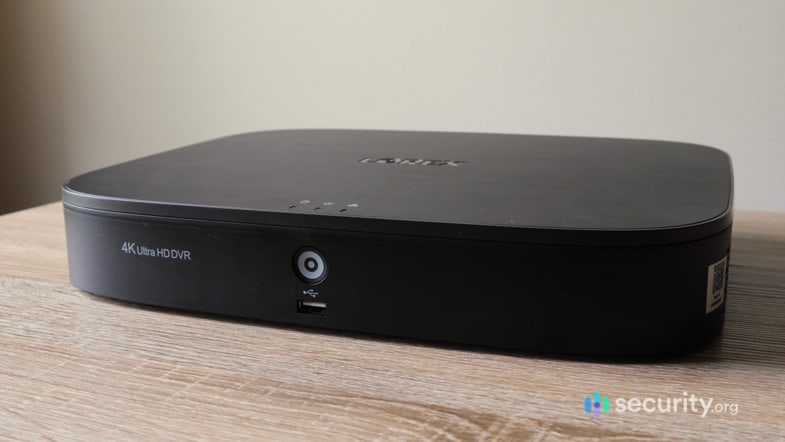
Lorex has one of the largest lineups of security camera systems with local storage. Most systems offer 1TB of storage or more. Their systems start at 1TB standard, but their latest models offer up to 16TB out of the box. In our experience, 2TB holds roughly 40 days of continuous 1080p footage from a single camera, or about 10 days with four cameras running.
Another feature we liked when reviewing Lorex is its expandable storage options. Current Lorex NVRs offer expandable storage up to a maximum of 32TB with up to four hard drives. That’s enough for months of footage from multiple cameras.
One of the downsides is the upfront cost. MicroSD cards are a more budget-friendly option, but they’re also easy to steal. DVRs and NVRs are easier to conceal and store more footage. However, they cost more with entry-level NVRs starting around $450, while basic DVRs can be found for about $350.
FYI: Lorex recently created separate websites for its residential and commercial-grade cameras. Now, you must register as a Lorex business partner to access the commercial-grade cameras.
Are Security Cameras Without Wi-Fi Harder To Install?
The short answer is no. There are wireless cameras that don’t need internet access since they rely on cellular networks. Two of our favorites are the Reolink Go and Arlo Go. Installing these is as simple as mounting them and popping in a SIM card. We had our Arlo Go 2 up and running in under 10 minutes.
We found installing cameras that record to DVRs trickier. These devices connect via Ethernet or coaxial cables. If you want to hide them, you’ll need to run them through walls or floors. Our recent eight-camera Lorex installation took about six hours total. We think it’s best to split these installations across two days to avoid getting overwhelmed.
Expert Tip: To minimize the amount of wires running through your house, consider installing Power over Ethernet cameras. The same cable is used for power and to send video to a DVR.
Wi-Fi vs. No-Wi-Fi Cameras
Let’s break down the real-world differences between Wi-Fi and no-Wi-Fi cameras, based on our extensive testing of both types.
Wi-Fi Cameras Pros and Cons
Pros
- No data plans required: Since you probably already have Wi-Fi in your home, you won’t have to pay for any additional data plans.
- Live streaming: You’ll be able to see what’s going on at home through your mobile app.
- Remote control: Most cameras also allow for remote control, including arming and disarming, zooming in optically, and speaking through two-way audio.
- Notifications: Modern cameras with AI can now distinguish between a delivery person, your neighbor’s cat, and an actual intruder with the most advanced offering facial recognition. This dramatically reduces false alarms compared to older motion-only detection.
While some cameras that don’t require Wi-Fi have these features, again, they’ll require data plans for a price.
Cons
- Bandwidth usage: Wi-Fi cameras can easily crowd your network. The livestream of a 4K security camera takes about 25 percent of the average home Wi-Fi network’s bandwidth of 74 Mbps.4 That alone can cause internet slow downs for the rest of your internet-connected devices.
- Faulty Wi-Fi: Cameras that are heavily reliant on Wi-Fi can be rendered useless by a simple internet outage. Is your internet provider reliable enough, or does the Wi-Fi go out more often than you’d like? If it’s the latter, then a camera that doesn’t require Wi-Fi might work better for you.
- Hacking: As we’ve seen with Ring cameras5, Wi-Fi cameras can be hacked, especially if you don’t protect your network and mobile app with a secure password.
FYI: For better Wi-Fi coverage, we recommend using a mesh network with multiple access points. We recommend using Nest Wi-Fi, which is one of the best smart home devices available.
No-Wi-Fi Cameras Pros and Cons
Pros
- They’re not as hackable. Cellular connections use encryption protocols that are harder to hack than typical Wi-Fi signals5 If you use an IP, Analog, or HD-over-coax camera system, it will be even harder to hack as an intruder would need physical access to your recorder to affect your cameras.
- You may still be able to get remote features. If you use a data plan, you don’t have to miss out on remote control, notifications, and live streaming, which are the main benefits of smart home security. The newest hybrid systems even let you automatically fail over to cellular if your Wi-Fi drops, ensuring you never lose coverage.
While some cameras that don’t require Wi-Fi have these features, again, they’ll require data plans for a price.
Cons
- They may require a data plan. Expect to pay $10 to $30 monthly per camera for cellular connectivity, which adds up fast. Four cameras could cost you $160 monthly just for data.
- They’re bulky.DVR-based systems require dedicated storage space. A typical 16-channel NVR is about the size of a desktop PC and needs proper ventilation to prevent overheating.
- They’re expensive. Professional-grade CCTV systems start around $1,000 for a basic 4-camera setup, compared to $200 to $400 for comparable Wi-Fi systems.
Recap
After testing dozens of cameras both with and without Wi-Fi, we find that non-Wi-Fi cameras are only ideal for specific situations. It might not always be feasible though. The cost of setting up and maintaining cellular-ready security cameras might be too high for some. The lack of alerting and streaming features of security cameras with local storage might be a deal-breaker for others. That’s why if possible, we recommend using internet-connected security cameras.
If you absolutely need video surveillance for a property without Wi-Fi, though, we recommend Lorex and its cameras that can record locally. Their systems offer rock-solid reliability and professional-grade features that genuinely deter crime. And if that doesn’t work, at least you’ll have recordings of any incident thanks to its 24/7 recording.
Frequently Asked Questions
Based on thousands of reader questions, we've compiled the most common concerns about Wi-Fi-free security cameras.
-
Can wireless cameras work without Wi-Fi?
Yes, wireless cameras can absolutely work without Wi-Fi. The Arlo Go and the Reolink Go, for example, are both wireless cameras that use cellular data plans instead of Wi-Fi.
-
Do all home security cameras require Wi-Fi?
Not all home security cameras require Wi-Fi. Some cameras, like the Arlo Go and the Reolink Go, can use LTE plans instead of Wi-Fi. Other home security cameras aren’t connected to the internet at all but rather record onto local storage like hard drives.
-
What is better, wired or wireless security cameras?
Both have pros and cons, wireless cameras are easier to install but their connection is less dependable. Completely wireless cameras are battery-powered, which has its own set of issues. Wired cameras are harder to install, but provide a more dependable signal. If a wired camera needs to be plugged in or hardwired to your electrical system, it can limit where you can place the camera.
-
Can you set up cameras without the internet?
Yes, you can set up cameras without the internet. Many cameras are local only, recording onto local storage like a micro-SD card or hard drive.

